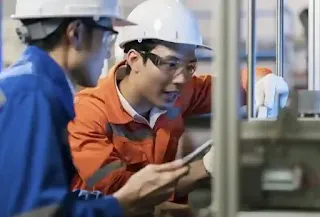In today's manufacturing landscape, CNC machining stands as a cornerstone. With the USA and China emerging as global manufacturing titans, it's essential to understand the cost dynamics and quality benchmarks in both nations. This article dives deep into the world of CNC machining, comparing the USA and China in terms of cost, quality, and overall value.
Background: Understanding CNC Machining
What is
CNC Machining?
CNC (Computer Numerical Control) machining
is a process used in the manufacturing sector that involves the use of
computers to control machine tools. It's the magic behind the precise
components in everything from automobiles to electronics.
Types
of CNC Machining Processes
There are various CNC processes, including
milling, turning, and drilling, each tailored for specific manufacturing needs.
Industries
Relying on CNC Machining
From aerospace to healthcare, numerous
industries depend on CNC machining for precision, efficiency, and scalability.
The USA CNC Machining Landscape
History
and Evolution
The USA's journey with CNC machining began
post-World War II, evolving with technological advancements and market demands.
Major
CNC Machining Hubs
States like Michigan, Ohio, and California
have become synonymous with high-quality CNC machining services.
Average Cost
Structure
Labor Costs: The USA boasts
skilled labor, but at a premium.
Material Costs: Access to diverse
materials, but often at higher prices.
Overhead and Operational Costs: High due to stringent regulations and standards.
Quality
Standards
The USA adheres to global quality
benchmarks, ensuring products that stand the test of time.
The Chinese CNC Machining Landscape
History
and Evolution
China's CNC journey began later than the
USA's but has seen rapid growth, thanks to massive investments and a focus on
technology.
Major
CNC Machining Hubs
Regions like Shenzhen and Guangdong have
become global CNC powerhouses.
Average
Cost Structure
Labor Costs: Competitive, given
the vast workforce.
Material Costs: Direct access to
diverse raw materials.
Overhead and Operational Costs: Often lower due to economies of scale.
Quality
Standards
China has made significant strides in
quality, now rivaling, and sometimes surpassing, western standards.
Factors Influencing the Cost of CNC Machining Services
Machine Setup Costs
1. Overview of Setup Costs and Their Impact on Pricing
Machine setup costs refer to the expenses
involved in preparing a CNC machine for a specific job. This includes
calibrating the machine, programming it for the task, and any other preparatory
work. These costs are often fixed and can significantly influence the overall
pricing, especially for short-run projects.
2. Comparison Between USA and China in Terms of Setup Costs
In the USA, with its advanced technological
infrastructure, setup costs can be higher due to the use of cutting-edge
equipment and software. In contrast, China, with its focus on mass production
and streamlined processes, often manages to reduce these costs, making it more
competitive, especially for bulk orders.
CNC machining experts from Art
Machining, a reputable and popular CNC machining
factory in China, can complete the manufacturing process at least 40% cheaper
than manufacturing factories in the USA.
Material Selection and Availability Considerations
1. Impact of Material Choice on Overall Cost
The choice of material can significantly
influence the cost of a CNC machining project. Premium materials like titanium
or specialized alloys will invariably cost more than standard materials like
aluminum or steel. Additionally, the processing requirements for different
materials can vary, further impacting the cost.
2. Availability and Cost Differences Between the USA and China
China, with its vast resources and
proximity to several raw material-rich nations, often has an edge in material
availability and cost. The USA, while having access to diverse materials, might
face higher costs due to import duties or transportation expenses.
Labor Costs
1. Comparison of Labor Rates in the USA and China for CNC Machining
Labor costs in the USA are notably higher
than in China. The USA boasts a skilled workforce demanding premium wages,
while China, with its vast population, offers skilled labor at more competitive
rates.
2. Influence of Labor Costs on the Final Price
Labor costs can significantly impact the
final price of CNC machined products. In projects requiring intricate detailing
or manual oversight, the difference in labor costs between the US and China can
be a decisive factor in the overall project cost.
Affordability Comparison: USA vs China for CNC Machining Services
Operating Costs Differences
1. Cost Factors That Affect Pricing
Several operating costs can influence CNC
machining pricing. These include electricity expenses, which can vary based on
local tariffs, taxes, which can differ significantly between countries, and
regulatory compliance costs, which can be higher in regions with stringent
manufacturing standards.
2. Evaluation of Operating Costs Between the Two Countries
China often benefits from lower electricity
tariffs and government incentives aimed at boosting manufacturing. The USA,
while offering a robust infrastructure, might have higher operating costs due
to stricter regulations and higher taxes.
Scale Economy Advantage
China's manufacturing ecosystem is built
for mass production. With numerous large-scale factories equipped for
high-volume production, China can achieve economies of scale that often elude
smaller-scale operations in the USA. This scale advantage means that per-unit
costs in China can be significantly lower, especially for large orders.
Cost Comparison: USA Vs China
Directly comparing costs reveals that China
often offers more competitive rates, especially for bulk orders. However, it's
crucial to factor in indirect costs like shipping and customs. Currency
exchange rates also play a pivotal role in the final cost calculations.
Quality Comparison: USA Vs China
The "Made in China" tag has long
been associated with affordability, but there's a growing realization that it
doesn't imply compromised quality. Both nations have showcased exemplary CNC
products, with technology and automation playing a significant role in
maintaining quality standards.
Why China Often Emerges as a More Affordable Option
China's affordability isn't just about
labor costs. Government incentives, a focus on mass production, and proximity
to raw materials all contribute to making Chinese CNC machining a
cost-effective choice.
Addressing Quality Concerns: Is Cheaper Better?
China's manufacturing evolution has
debunked many myths. With numerous global brands relying on Chinese CNC
machining, it's evident that affordable doesn't mean low quality. However, due
diligence is essential when selecting a manufacturing partner.
Potential Drawbacks of Outsourcing to China
While China offers many advantages,
challenges like communication barriers, longer shipping times, and intellectual
property concerns can arise. It's essential to weigh these factors against the
benefits.
Making an Informed Decision: Factors to Consider
Choosing between the USA and China for CNC
machining isn't just about cost or quality. Consider the total cost of
ownership, lead times, and geopolitical factors to make an informed decision.
Consider Outsourcing Your CNC Machining Needs?
Considering outsourcing your CNC machining
needs? Experience the competitive edge of Chinese manufacturing with Machining
Now, a leader in precision CNC services. Dive
into affordability without compromising on quality. Reach out to us today!
Conclusion
The CNC machining landscape is vast and
varied. Both the USA and China offer unique advantages. By understanding the
nuances of each market, businesses can make decisions that align with their
goals and needs.
Frequently Asked Questions
Why is CNC machining popular in manufacturing?
CNC machining offers precision,
scalability, and efficiency, making it a preferred choice for various
industries.
Is "Made in China" synonymous with low quality?
No. While China offers affordability, it
doesn't compromise on quality, especially with advancements in technology and
quality control measures.
What are the hidden costs when outsourcing CNC machining to China?
Beyond direct costs, consider shipping,
customs, currency exchange rates, and potential communication challenges.
How do I ensure I'm partnering with a reputable Chinese CNC
manufacturer?
Research, seek recommendations, and
consider visiting the manufacturing facility if possible.
Are there industries that particularly benefit from Chinese CNC
machining?
Industries that require bulk production,
such as electronics and automotive, often find Chinese CNC machining
particularly cost-effective.









0 Comments